Digital Green Revolution : Developing a sustainable value chain in agriculture sector in Industry4 -How technology infusion can bring about large scale improvements
India has been an agriculture dependent economy for a long time. Initial decades after independence saw very little improvement on total agro output as well as yield. The data shows low level of production in 1950’s due to lack of focus on agriculture sector and use of primitive techniques. This was result of technological backwardness and lack of Govt. priorities. Next few decades saw gradual increase in production largely due to the Green revolution, spearheaded by the states of Punjab, Haryana, Western Uttar Pradesh taking the lead in increase of agriculture production in the country. Production of food grains which was very low in context to its demand grew after green revolution e.g. production of wheat which was 11.1 million tonnes in 1960s, ultimately increased to 109 million tonnes in 2021 (Source: Ministry of agriculture & farmer welfare). Total food grains production which was 50.8 million tonnes in 1950-51 increased to 303.34 million tonnes in 2021. (IBEF report 2021).
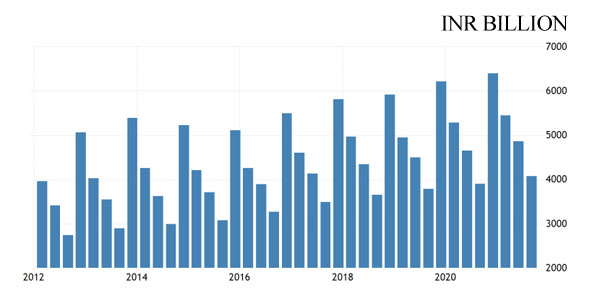
It is estimated that India’s agriculture sector accounts for only around 14 percent of the country’s economy (GDP) but for 42 percent of total employment.
 The Indian agricultural sector is expected to increase to US$24 billion by value by 2025 (source INC42 report). India is the world’s second-largest producer of rice, wheat, sugarcane, cotton, groundnuts and fruits & vegetables. It also produced 25% of the world’s pulses, as of last decade, until 2019.
The Indian agricultural sector is expected to increase to US$24 billion by value by 2025 (source INC42 report). India is the world’s second-largest producer of rice, wheat, sugarcane, cotton, groundnuts and fruits & vegetables. It also produced 25% of the world’s pulses, as of last decade, until 2019.
However despite making India food sufficient there is a scope of large scale improvement in use of technology in the overall agriculture supply chain. We see a low usage of technology starting with very low farm mechanization at the bottom of the technology stack to the use of high end technologies like data analytics, artificial intelligence, automation etc. Usage of these smart technologies can improve productivity and efficiency in the entire food value chain in a big way.
Though India has food sufficiency by way of adequate production, it still lacks in providing broad base food security to a large part of the population. India ranked 101 in Global Hunger Index of 116 countries (GHI report 2021). Dark spots like malnutrition, hunger and poverty associated with it could be reduced significantly in the next decade by using technology. A large global economy like India, aiming to become a $5Tn economy by 2025 needs to take urgent actions to improve lives of a large part of its population engaged in agriculture.
Issues and challenges for the sector:
Low farmer income, uncertainties associated with the farming, poor economic yields (debt trap), wastages, low yields, low mechanization, higher production costs, low productivity, middlemen commissions, uncertain crop insurance are the key challenges for the sector which is one of the most important part of the national economy.
Average Indian farmer income is small by global standards (USA:$44,155, India:$1635). Low land holdings also pose agri ownership/management problems. As per Govt. data more than 70% of farmers in India have land holding of less than 1 hectare (India stats 10th census of land holding). To increase farmer income from current Inr122,616 (around$1635) to INR250,000 per hectare (doubling farmers income in India by 2023, Niti Aayog policy paper no. 1/2017) would need an inclusive and decisive action plan for the entire value chain. This would call for a complete review of technology infusion and productivity enhancement in the agriculture.
Low productivity as a result of inefficient farming has been a major issue with India. Currently, India produces 106.19 million tonnes of rice a year from 44 million hectares of land. That’s a yield rate of 2.4 tonnes per hectare, placing India at 27th place out of 47 countries. China and Brazil have yield rates of 4.7 t/ha and 3.6 t/ha, respectively. If Indian agricultural productivity was at these rates, we could produce 205.52 million tonnes and 160.01 million tonnes of rice, respectively. Egypt leads the world in rice yields—at Egypt’s yield rate, India could almost triple its rice output. (OECD FAO agriculture database)
As far as wheat is concerned, India has a higher yield rate than for rice, but it still lags a large part of the world. With 93.51 million tonnes of wheat from 29.65 million hectares, India’s yield rate of 3.15 tonnes per hectare places it 19th out of 41 countries. If India’s wheat productivity was at China rate (4.9 t/ha), we would be producing 147.53 million tonnes of wheat, at same time reducing land required for cultivation by a whopping 36%.
On the resource optimisation we see large scale seed wastage, excess use of fertilizer, water, human efforts, unscientific usage of ground water leading to depleting ground water levels as key challenges. Soil health degrading, replacing top soils, weeds & pest control, irrigation management, crop specific soil preparation, soil specific mechanization are next level challenges to be solved.
Moving on the value chain we find that lack of value add products, storage & preservation, logistics, sorting, washing, grading, processing, branding, packaging, meeting required food grade specs, certification and norms for exports are key challenges for the sector. India needs 350Mn MT of cold chain capacity for storage. India produces 400Mn MT of perishables and wastes 16% with the value of losses estimated at $12Bn. (Source: Ministry of Food Processing Industries-Govt. of India). This colossal wastage ends up increasing miseries for the farmers. Produce wastage has a multiplier effect since it get wasted at the end of the supply chain.
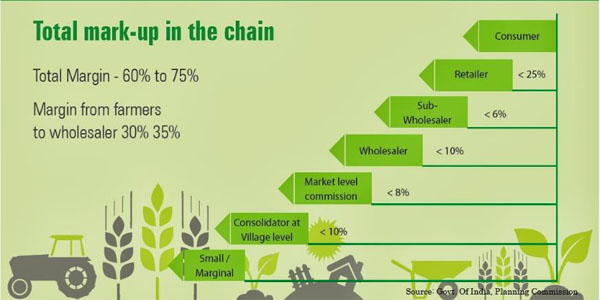
What is the solution :
Technology can solve large part of the problem. A holistic technology intervention system needs to be created across the entire agri value chain in the Industry4 era. Target should be to create an agri supply chain which is scalable, sustainable, globally competitive and offers agriculture as work place of choice to large section of the country.
Industry4 can play a vital role in providing answers to all the above. In the digital world of I4, a large scale technology intervention is proposed for Indian agriculture sector.
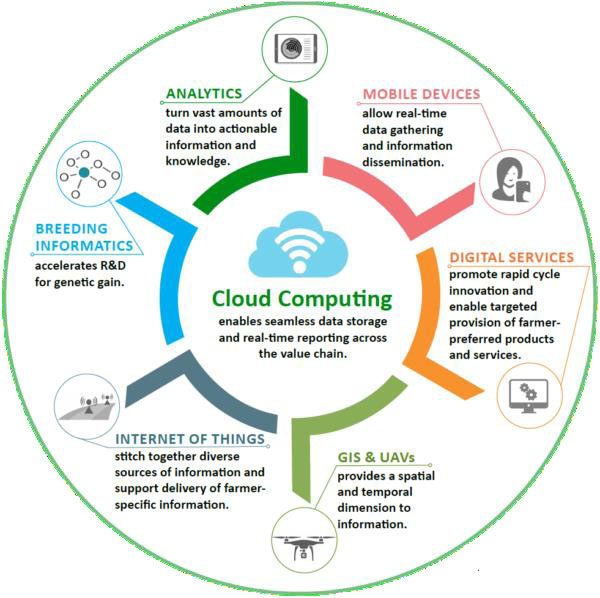
A large part of the agri value chain problems could be successfully addressed by technology infusion. The building blocks of the value chain in Industry4 eco system are shown as below.
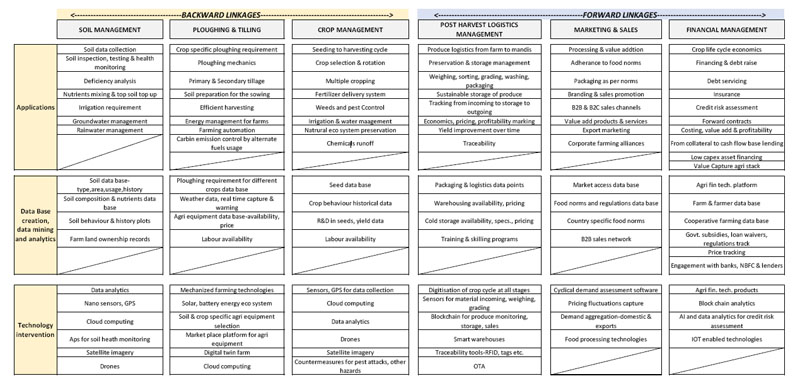
The start of the agriculture value chain is soil management. This is where lot of scientific inputs are required.
Starting with soil preparation, soil health monitoring and soil preservation are key issues. The Indian Council of Agricultural Research (ICAR) has classified soils into 8 categories. Major % are: Alluvial Soil (43%), Black Cotton Soil (15%), Red Soil (18.5%). Rest are Laterite Soil, Mountainous or Forest Soils, Arid or Desert Soil, Saline and Alkaline Soil, Peaty and Marshy Soil as categories of Indian Soil. Each type of soil presents different challenge for preservation, selection of fertilizer to complete the deficiencies in the soil etc. Scientific agriculture needs data based cultivation which includes soil specific treatment with fertilizer, chemicals and selection of crops. Irrigation is a critical part of the cultivation chain, with Indian farmers largely dependent on the rains. Monsoon cycle is a very important factor influencing the entire agri economy and large part of the national economy.
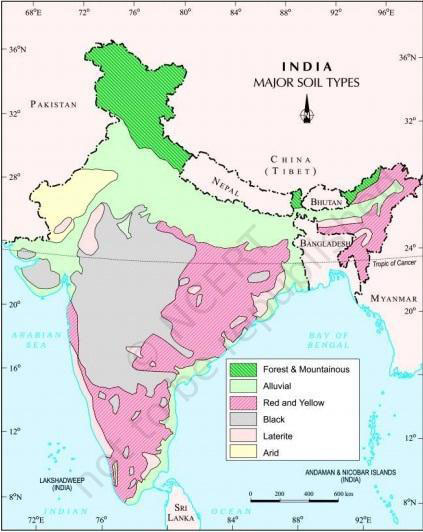
Second most important source of irrigation are the rivers followed by ground water. With over and unplanned use of ground water in the country, the ground water table in several states have depleted to dangerous levels. India uses some 230 km3 of groundwater per year, making it the world’s largest user of groundwater (World Bank, 2012). In India, about 90% of the groundwater extracted is used by irrigation—a much higher proportion than the global average of some 40% (Siebert et al., 2010).
Irrigation is the single biggest variable factor for the success of the crop, after seeds. Traditional methods along with high dependence on rains has been a cause of high level of uncertainty associated with agriculture. Crop & soil specific modern techniques like drip irrigation, sprinkler, sub surface irrigation can be chosen based on the data available and crop health can be monitored. Precision watering of crop can be achieved by controlling water flow with precise choice of droplets. With rain water harvesting wastages and run off too can be controlled.
Technology intervention in this block is in maintaining soil data base of area under farming. The regular testing and inspection of soil will help maintain soil composition for efficient farming. The data can be uploaded on cloud for processing and then soil specific treatment could be generated by data analytics and artificial intelligence tools. The sensors, GPS, satellite imagery and drone will keep data base updated and also provide information on unusual changes in the soil culture.
Next block in the agri value chain is the ploughing and tilling. This is where lot of manual and machine work happens. Crop specific ploughing is needed to minimise costs. In India relay cultivation is used for cultivation of crops like rice and chickpeas. This helps farmers cultivate two crop in one Kharif season making use of the moisture left in the rice fallows. Technology intervention in this block relates to farm mechanisation by tractors and using proper implements. RBI report estimates the current level of farm mechanisation in India at 40-45 per cent. It is much lower compared to other advanced economies such as the U.S (95 per cent), Western Europe (95 per cent), Russia (80 per cent), Brazil (75 per cent) and China (48 per cent).
Technology assisted selection of farm implement can improve efficiency of farming. E.g. black soil in the MP will need more power than the alluvial soil of the north India. Studies have shown the field efficiency of farm equipment black soils becomes 0.18ha/hr. as compared to 0.28ha/hr in case of sandy soil. The efficiency of implement in black soil to be 60% as compared to the 75% of sandy soil thereby increasing fuel consumption from 5ltr/hr. to 5.14ltr/hr.
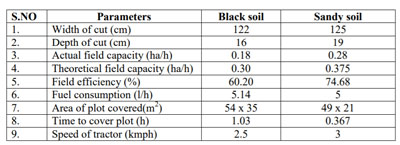
Cost is an important factor in ploughing and tilling using tractors. In India biggest category of tractors sales are in 45-75HP costing 8-10 lacs. Looking at the land holdings, usage and crop pattern, tractor in the range of 25-30HP should be sufficient. Battery run electric tractors are going to be the next disruption in this sector. These offer not only a low cost alternative to the diesel based one but also an electric motor run tractor could be configured easily for power based on the soil requirement. This will offer more efficient farming to the farmer at a lower cost. The tractor battery could be charged using solar power charging stations in the field. Proper selection of tractor and other mechanised implements is the key to enhancing efficiency and effectiveness of ploughing. Soil data base will provide data for farm mechanization. An on-line market place could be created where farmer can access these machines and tools at competitive rates by simply checking availability, price on line and pay for use.
Next block is the crop support and management from seed selection, fertilizer delivery to irrigation management. Selection of proper quality of seeds is most important part of the entire chain. Right type and amount of fertilizer is critical to sustainable crop management. Most of the time in India the farmer is throwing fertilizer by hand as well as spraying the fields with weed control chemicals manually. This is an inefficient as well as uncontrolled activity.
Technology intervention here makes seeds and fertilizer delivery using drones and other UAVs. This is highly effective compared manual spray. Advanced drones with droplets of 50/sq. cm with varying sizes from 70-250 micron can cover 100 acres/day as compared to 5 acres/day manually. The fertilizer sprays are consistent on both sides of the leaves as compared to only one side getting covered by manual spray. This is an important point as insects usually attack the plants from underside of the leaves. Consistency of fertilizer delivery, efficacy and uniformity of delivery ensure crop retention with high efficiency..
On the forward linkage of the agri supply chain first is the post harvest logistic management. This involves transport to mandis or procurement centres. A very important part of the supply chain involves preservation and proper storage of the produce. This involves sorting, weighing, storage under control temp. conditions. The wastage levels of Indian perishable commodities can change by creating smart warehouses and integrated cold chains using modern storage technologies. Warehouses are managed by blockchain technology for monitoring storage and movement of goods. It also allows tracking of products using bar coding, RFID, GPS etc. A price monitoring system keeps track of commodity price movement and allows farmers to decide appropriate sale timing based on best price realization. Properly stored and packed food complying with regulations can be branded and sold at a much premium price than ordinary sale conditions. This is where technologies like blockchain, data monitoring using temp censors, bar coding etc. bring in value for the farmers. Linked to the logistics and storage is the marketing and sales activity. This is where customer relationship management, market access, branding and pricing etc. backed by modern data analytics technologies come in. Despite producing 200 Mn MT of wheat and rice India is not really high on global food supply chain. Exports should be priority for any country in modern world. Cooking oil e.g. is the second biggest import for India with import of 13.53 million ton valued at $13Bn a year in 2021, up 63% from previous year (Solvent extraction association of India report Nov’21). Indian local production of cooking oil is 10 million ton. This can be increased by increasing production of oil crops like groundnut, soybean, rapeseed-mustard, sunflower and coconut and oil palm as plantation crops. On top of it rice bran and cotton seed oil contribute largely to the oil production of the country. (Source: turning India self reliant in edible oil-retrospect and prospect: Mukti Sadhan Basu Ph.D.). Market platforms focussed on export can open export markets of Indian agri products to the world.
Last link in the agri value chain is financial module. This captures the financial efficiency of the entire value chain. Agri financing is expected to be the new major industry where maximum fin tech. disruption is going to happen. Even though agriculture is under Priority Sector Lending (PSL), still more than 70% of the farmers do not have access to institutional credit and remain dependent on informal credit paying interest rates as high as 60%. The weighted average cost of capital (WACC) for an average Indian farm (about 1 hectare size) continues to be over 20% per annum, because of heavy dependence on informal high-cost credit. (Source INC42). Organized lenders are wary of lending to farmers due to high degree of uncertainties involved in the farming, topped up with political interventions of loan waivers etc. Here technology can play a major role starting from farm data-land records, geographical data to farmer database for credit assessment. Digitisation of both is easily done by data capture tools. Using block chain this data will become impossible to amend. The business side risk assessment can be done by estimating and forecasting crop based future cash flows. Based on these data, fintech companies, banks can come up with innovative products. Instead of collateral based lending, a more market inclusive future cash flow based financing can be adopted. Data based NPA prediction tool by using AI and data analytics tools can be created.
Conclusion:
Indian agriculture industry provides livelihood to a very large section of the society. For long it has remained unorganised, fragmented and low in usage of technology. Small and marginal farmers economic situation has not improved due to large scale uncertainties and poor realisation for his produce. The entire supply chain has multiple linkages where costs get added up and eat up the farmer margins. Technology in the Industry4 realm could be the answer to these issues and challenges. Industry4 is a paradigm shift where several of the modern technologies will get integrated. These technologies are industry agnostic as well as highly scalable which brings in cost benefits. Technologies like high end data analytics, artificial intelligence, IOT operating on 5G network could provide solution to every block in the food value chain mentioned in the framework above. Large scale technology intervention could change the way farming is done in India and create more value addition at every link of the chain. In the end we can have a significant value capture for every stakeholder in the chain. Agriculture needs to become a large value add industry with Farming-as-Service concept. Modern farming needs to combine the entire technology eco-system of data analytics, mechanization, handling, storage, logistics and value add products. It is possible in the fast approaching integrated world of technology under Industry4. India needs the second Green revolution or let’s call it Digital Green revolution brought in by clean, sustainable technologies in Industry4. This would mean a radical change to the lives of 120 million farmers in India.
About the Author

Dr. Deb Mukherji, Ph.D.,
Managing Director
Omega Seiki Private Limited a member of the Anglian Omega Network.
Dr. Deb after receiving his PhD in Economics where he presented a detailed evaluation of the global competitiveness of the Indian auto-component industry, Dr. Mukherji has gone on to have a stellar and rewarding career in the automotive and related industries. He has worked with leading Indian as well as global companies such as Suzuki and Honda and has set-up greenfield plants across India, Mexico and Thailand. As a result of his experience and expertise, numerous foreign companies have developed and grown their India strategy under his guidance.
He can be contacted @
Linkedin : https://www.linkedin.com/in/deb-mukherji-ph-d-a0b4bb12/
Email : [email protected] , [email protected]
Twitter : https://twitter.com/OSMobility_IN
FaceBook : https://www.facebook.com/OmegaSeikiMobility/
LinkedIn : https://www.linkedin.com/company/omegaseikimobility/
Also read his earlier article











